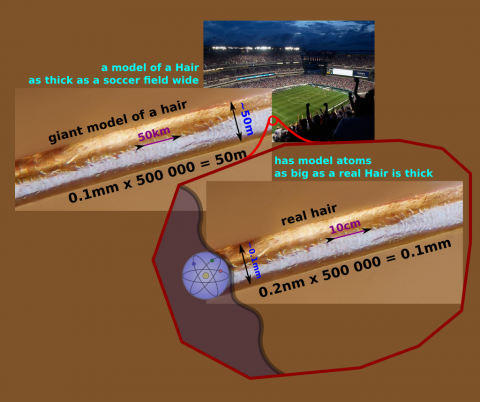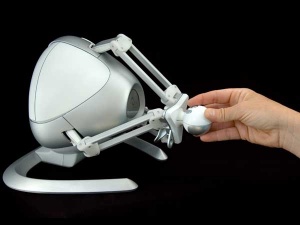Intuitive feel
This is an introduction to the character of robotic work in the nanocosm.
It should deliver some intuitive feeling of how things work down there.

Contents
How big is an atom?
Atoms are quite small but they are not as ridiculously small as people usually say. If a hair (0.1mm) would be the width of a soccer field (~60m) an atom would be roughly the size of a hair. Carbon is about 0.2nm or 2Å in size that makes roughly five atoms per nanometer. When hierarchically building up building structures one can quickly fill up this size gap.
Relative distances in the other (astronomic) direction are vastly greater. If the planetary orbit of our outermost planet Neptune (which can technically be reached in years) where the size of a hair the nearest stars would lie beyond ~1km and the milkiway would be ~1000km thick at our location. The next galaxies would start at the diameter of our sun ~1000000km then still follows the unimaginable size of intergalactic voids, the observable universe and the universe extrapolated to our "now" of which we now little by now.
How does it feel when you grab two atoms and rub them against each other?
First I should note that trying this out for real is actually possible for quite a while now (as unbelievable as it may sound). To feel atoms you grab the end of a robot (you shake hands with it). A tiny needle with a single atom at the tip is then made to move exactly like your hand just on a lot smaller scale. When the topmost atom on the needle tip starts to touch an atom on a surface the robot arm pushes back just as the surface pushes back on the needle albeit with a magnified force big enough for you to conveniently feel it. This is called force feedback (commonly known from car racing games).
Two analogies that might convey what it feels like best are:
- rubbing soft slippery fish or water soaked gummy bears against each other
- moving two magnets past each other in repulsive (but sometimes also attractive) configuration
Moving the robot arm in and outward you can check out softness and moving sideward you can check out slipperiness.
Slipperiness
Atoms are ridiculously slippery. Like the moon orbiting the earth there's basically no friction. If certain conditions are met this low friction can be retained for certain a bit unusual assemblies of atoms. This has enormous technical benefit. It is called the superlubrication phenomenon.
Softness
So how does it feel to break a single bond between two atoms? Since I can't let you pull on this robot arm over the web lets turn the robot arm facing downwards and tie an empty plastic bottle onto it in which we will later fill some water. We can also use a simple coil spring instead of the robot arm giving force feedback
For realism we can make the robot arm behave exactly as stiff as the bond between two atoms. Caution! Please do not mistake stiffness with force. Stiffness is how much the force grows per the length you pull. A bond between two atoms obviously has only a tiny force but this force builds up on a tiny distance. Thus while the robot arm needs to magnify both force and length the stiffness of the bond turns out to be in the right size such that the robot arm can simulate the it 1:1.
Now here's a quiz: Assuming you fill half a liter of water into the plastic bottle how much will the robot arm simulating the a bond between two carbon atoms in diamond give (very roughly)
A:~1mm B:~1cm C:~1dm
Hidden solution:
- A C-C bond has a (maximum) spring constant of: k = 440N/m =~ 450g/cm -- thus half a liter of water which makes 500g bends the setup ~1cm so the answer is B
- halving the size -> halves the stiffness ... the smaller things are the floppier they become ... this is an instance of a scaling law of whom you'll here a lot here
- even diamond one of the strongest materials in existence feels pretty soft at the scale of single atomic bonds
What happens when you let go of a building block?
Let's consider an somewhat unusual fall experiment. A small gripper let go of a building block. Simple? See if you answer right.
Scaling laws
They describe what changes when one goes down the scale. E.g. that magnetic motors become weak but electrostatic ones strong. More details can be found at the scaling laws main page.
The feel of AP Products
AP products though robotic and gemstone like in the nanocosm are not necessarily cold hard and robot like to the human senses. Emulated elasticity can create any form imaginable with gradients from soft to hard. It isn't an easy to attain property but it is an highly desirable one and will emerge at some point.
Bonding energies - Tensile strengths - Stiffnesses
[Todo: Add table - make it visualizable for covalent bonds and VdW bonds]
[Todo: show surface area thats VdW ashesion is energetically equivalent to one covalent bond - related: Form locking]
Brownian motion in nanorobotics
- Envelope of throwing trajectories with same speed
- Throwing trajectories with various speed in same direction
Further
- acceleration limits
- jumping building blocks

